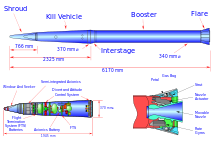
THAAD system
Work on THAAD began in 1987, focusing on thermal homing, cooling solutions, and system speed. Photo MDA
Terminal High Altitude Area Defense (THAAD) is a missile defense system that is part of an integrated system known as the Ballistic Missile Defense System (BMDS). THAAD is a mobile system that can be transported anywhere in the world in a very short time and, once deployed, immediately used against emerging threats.
THAAD is a response to the threat posed by ballistic missile attack with weapons of mass destruction. The principle of operation of the anti-missile complex is to destroy an enemy ballistic missile due to the kinetic energy obtained when approaching the target (hit-to-kill). Destruction of warheads with weapons of mass destruction at high altitudes significantly reduces the danger of their ground targets.
Work on the THAAD anti-missile system began in 1987, the key areas were the homing infrared warhead of the target, the speed of the control system and advanced cooling solutions. The last element is crucial because of the high speed of the oncoming projectile and the kinetic way of hitting the target - the homing warhead must maintain maximum accuracy until the last moment of flight. An important distinguishing feature of the THAAD system was the ability to deal with ballistic missiles in the Earth's atmosphere and beyond.
In 1992, a 48-month contract was signed with Lockheed for the demonstration phase. Initially, the US Army wanted to implement a limited-capability missile defense system and this was expected to be achieved within 5 years. Then the improvements were supposed to be made in the form of blocks. Initial failed attempts led to delays in the program, and the baseline was not developed until eight years later. The reason for this was the limited number of tests and, as a result, many system errors were detected only during its practical checks. In addition, there was too little time left to analyze data after unsuccessful attempts and to make possible adjustments to the system. The enormous need to put it into operation as soon as possible led to insufficient equipping of the first anti-missiles with appropriate measuring equipment, which makes it possible to collect the optimal amount of data necessary for the correct development of the system. The contract was also structured in such a way that the risk of cost increases as a result of the test program fell mainly on the public side due to the way everything was funded.
Having identified the problems, further work was started, and after the 10th and 11th interceptor missiles hit the target, it was decided to move the program to the next stage of development, which took place in 2000. In 2003, there was an explosion at the plants producing m.v. for the THAAD system, leading to further delays in the program. However, in fiscal year 2005 he was in good shape on time and on budget. In 2004, the name of the program was changed from "Defense of the High Mountain Zone of the Theater of Operations" to "Defense of the Terminal High Mountain Zone".
In 2006-2012, a series of successful tests of the entire system was conducted, and situations in which the target was not shot down or the test was interrupted were not due to defects in the THAAD system, so the entire program boasts 100% effectiveness in intercepting ballistic missiles. The scenarios implemented included countering short-range and medium-range ballistic missiles, including neutralizing attacks with a large number of missiles. In addition to shooting, some additional tests were performed in the software layer by providing the system with appropriate data that simulates a set of assumptions for a given test, and checking how the whole thing can handle it in specific conditions. In this way, an attempt to repel an attack with a ballistic missile with several warheads, individual targeting.
